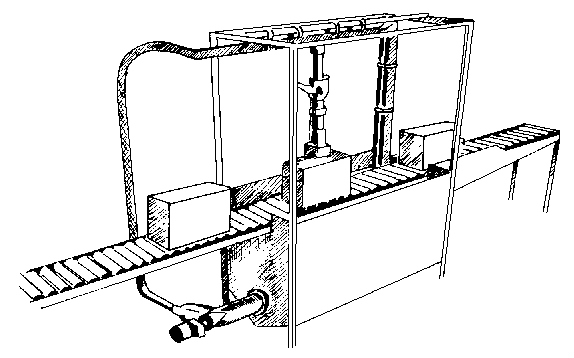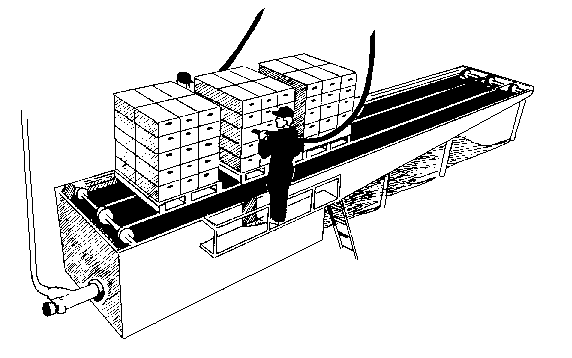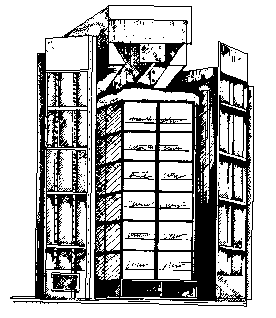In a competitive market, produce buyers demand the highest quality products. For many fresh fruits and vegetables, rapid and thorough cooling immediately after harvest is essential to preserving quality.
Ice has been used since early times to remove heat rapidly from food and to extend its shelf life. It is the preferred cooling method for many types of extremely perishable produce items. Ice not only removes heat rapidly when first applied to produce but, unlike other cooling methods, continues to absorb heat as it melts. Crushed and liquid ice cooling methods can be used effectively by growers with both small and large operations.
This publication is intended to help growers, packers, and shippers of fresh produce make informed decisions concerning the application of crushed and liquid ice cooling. Included are discussions of icemaking equipment and ways to purchase ice, types of produce that may be suitably iced, various produce-icing methods, how to calculate the amount of ice required to cool a given amount of produce, and the economic considerations of cooling with ice.
Choosing the Best Cooling Method
Crushed or liquid icing may be used on a variety of fresh produce. Icing is particularly effective for perishable items that cannot be readily cooled by other methods. Top icing a truck loaded with already cooled produce is a good way to provide additional assurance that the load will arrive properly cooled. However, icing in any form is not recommended for all types of fresh fruits and vegetables. Some items like strawberries, blueberries, and brambles cannot tolerate wetting. Other items, such as squash and tomatoes, can be injured by chilling to near freezing. Some produce items that can be successfully iced: asparagus, cauliflower, broccoli, green onions, cantaloupes, leafy greens, carrots, sweet corn.
For a complete list of produce items commonly grown in North Carolina and their recommended cooling methods, refer to Extension publication AG 414-1, Proper Postharvest Cooling and Handling Methods.
Block Ice
Until about 50 years ago, all commercially produced ice was made in rectangular blocks weighing about 300 pounds each. Block ice is still widely available during most of the year. However, occasionally during the peak of harvest season in North Carolina the demand for block ice may exceed the supply. During periods of shortage, block ice may be trucked into North Carolina at a much higher price reflecting, in part, the increased transportation cost.
Block ice is produced by much the same method used when refrigeration was introduced early in the twentieth century. Rectangular metal cans approximately 11 inches wide, 22 inches long, and 42 inches deep are filled with water and spaced in regular rows about 4 inches apart on the floor of a shallow pool. This pool is filled with brine, which is chilled to approximately 15°F and circulated past the cans. It often takes as long as four days to completely freeze the water in the cans. The technology for producing block ice is relatively inefficient in energy use and costly in terms of both equipment and labor. Block ice plants have been gradually replaced by the more efficient chip or flake ice plants. Because of its large volume-to-surface-area ratio, however, block ice can be trucked long distances or held for a considerable time without refrigeration and without appreciable loss from melting.
Availability of Ice on the Farm
Modern chip or flake ice makers are several times more energy efficient than block ice-making equipment and require much less labor. Unfortunately, chipped or crushed ice cannot be stored or transported in the large bulk lots required for produce cooling because it refreezes into a solid mass, making it difficult to use. However, when on-site ice making is not economically justified, as is the case for some short-season agricultural operations or small-volume growers, the purchase of ice in block form may be the only economical alternative.
When faced with an uncertain supply of expensive block ice, some moderate- and large-scale growers have opted to install their own ice-making equipment. The decision to purchase ice-making equipment should be made only after thoughtful consideration of both the benefits and costs. (See the section on Economics of Ice Cooling.) On-farm ice makers are often situated over or near an insulated enclosure or bunker that has sufficient storage capacity to hold one or two days' production of ice. Chipped ice stored for more than a day or so will freeze together into a solid mass. Therefore, both the ice maker and the ice bunker must be correctly sized to maximize utilization and minimize cost. A number of equipment manufacturers are now marketing ice makers and ice storage bunkers as modular units designed specifically for on-farm postharvest icing operations.
Containers
Many types and sizes of fresh produce containers can be used successfully with iced produce. Popular types include waxed fiberboard cartons; wooden wire-bound crates, baskets, and hampers; and perforated plastic liners. Any container that will retain its strength after wetting can be used satisfactorily with ice. Waxed fiberboard cartons are particularly well suited for icing operations. They have minimal openings, they offer some insulation to help reduce the rate of melting, and their strength is unaffected by wetting.
Ice Crushers
Block ice and some chip or flake ice must be crushed before it can be used for icing. Pieces of ice should be no larger than 3⁄8 inch so that they will penetrate the voids in the produce package. Also, small pieces of ice are much less likely to cause mechanical damage to the produce than large pieces. Electrically powered ice crushers can crush large blocks of ice to a suitable fineness. Some ice crushers are equipped with a blower that allows the ice to be distributed onto or over a load of produce.
Ice crushers can be extremely dangerous when improperly used. Anyone using a crusher must be properly instructed in its safe use, and all guards and safety devices must be in place. All electrical equipment, including ice crushers, should be equipped with an approved electrical ground.
Icing Methods
Individual Package Icing
The simplest icing method is to add a measured amount of crushed ice manually to the top of each carton filled with produce. This method is sufficient in many instances but can result in uneven cooling because the ice generally remains where it was placed until it has melted. Because each carton must be opened, iced, and reclosed, the process is slow and labor intensive. Individual package icing has been automated to some extent by ice-dispensing devices and the use of package conveyors and roller benches. Individual package icing is usually not considered for high-volume production.
Liquid Icing
Sometimes known as slush icing, liquid icing is the preferred method when large amounts of produce must be iced in a relatively short period of time. The required equipment consists of an ice crusher, a slurry tank with mixer, a pump, and delivery hoses.
In the simplest form of liquid icing, a mixture of water and finely crushed ice is pumped into open containers traveling along a conveyor under an injection nozzle, as shown in Figure 1. This method is a significant improvement over hand icing because the water carries the ice into the voids throughout the package, thus bringing it into greater contact with the produce.
Liquid icing may be considered a hybrid of package icing and hydrocooling. The chilled water in the slurry has a pronounced cooling effect on the produce. In the liquid icing of broccoli, it has been estimated that as much as 40 percent of the total product cooling is accomplished by the water alone. The balance of the cooling is accomplished by the ice as it melts inside the carton.
If the produce has been packed and palletized in the field, the water and ice mixture can be alternatively pumped from a hose into the hand openings of each container, as shown in Figure 2. This method is fast and effective, and it does not require that the cartons be opened or removed from the pallet. With the proper equipment, two workers can liquid ice a pallet of 30 cartons in about 5 minutes.
An even faster and more automatic method for liquid icing of palleted produce has been developed, as shown in Figure 3. A pallet of filled cartons is placed inside a metal enclosure that is rapidly filled with a slurry of water and ice. The water and ice penetrate all the voids in the cartons. After the enclosure is entirely filled, the excess slurry is drained away, leaving the ice inside the cartons. An automatic pallet-icing operation can be controlled by the lift truck operator alone.
The equilibrium temperature of a mixture of melting ice and water is 32°F. Users of liquid icing have occasionally added salt (sodium chloride) to the slurry in an attempt to lower its temperature and effect faster cooling. Adding 40 pounds of salt per hundred gallons of slurry will lower the temperature to approximately 27°F. However, this 5°F reduction in temperature will not reduce cooling time significantly. Furthermore, the brine solution may cause the produce to lose more water (wilt more) than is acceptable. Therefore, many produce buyers strongly discourage this practice. The brine solution may also contribute to the corrosion of the icing equipment.
Liquid icing is an excellent cooling method, although it does wet the produce. The surface of warm, wet produce provides an excellent site for postharvest diseases to develop. Therefore, it is essential that, once iced, produce not be allowed to rewarm. Produce that has been stressed by too much or too little water, high rates of nitrogen, or mechanical injury (scrapes, bruises, or abrasions) is particularly susceptible to postharvest diseases. To help reduce the spread of postharvest diseases, the North Carolina Agricultural Chemicals Manual recommends the use of chlorine as a disinfectant at a rate of 55 to 70 parts per million. Chlorine to be used in hydrocooling water can be purchased in the form of a sodium hypochlor-ite solution (for example, Clorox) or as dry, powdered calcium hypochlorite. For a thorough discussion of chlorination, refer to the Extension publication AG 414-6, Chlorination and Postharvest Disease Control.
Top Icing
Top icing is the placing of a 2- to 4-inch layer of crushed ice over the top of pallets of precooled produce. Trucks loaded with precooled fresh produce, such as hydrocooled sweet corn, are frequently top iced just before shipment. Top icing can add considerably to the shipping weight of the load. Top icing a 40-foot trailer can require 8,000 pounds of ice. It has been previously supposed that as the top ice melts, the chilled water would trickle down through the load to continue the cooling process. Tests have shown, however, that top icing affects only the uppermost layers of produce. Furthermore, the chilled water from the melting ice often passes through spaces between the cartons and pallets with little cooling effect. In general, top icing provides little additional cooling and is useful only in preventing an increase in temperature.
Calculating Ice Requirements
Ice may be considered a type of stored thermal energy. The melting of 1 pound of ice will absorb 144 Btu of heat. It has been shown that in most commercial icing applications, however, only about one-fourth to one-half of the ice is actually used to cool the produce. The rest is melted by the outside heat that passes through the sides of the container.
As an example of how to calculate the amount of ice needed to cool a given amount of produce, consider the icing of broccoli. Broccoli is an extremely perishable crop and is one of the most commonly iced fresh vegetables. Most buyers require broccoli to arrive with ice inside the container as proof of sufficient and continuous cooling. Broccoli is frequently packed in cartons containing approximately 20 pounds of product. Cooling 20 pounds of broccoli from 85°F to 45°F requires the removal of approximately 800 Btu of heat. Assuming that during shipping and handling another 1,000 Btu would enter the container from the outside, the total heat load per carton would be 1,800 Btu. Therefore, the minimum amount of ice required to provide proper cooling would be:
1,800 Btu/carton ÷ 144 Btu/pound of ice = 12.5 pounds of ice/carton
In actual practice, approximately 16 pounds of ice is required for each 20-pound carton of broccoli. The additional ice ensures proper cooling under extraordinary conditions. If the liquid icing method is used, another 10 pounds of ice per carton may be required to cool and maintain the water in the slurry at a low temperature. In this example, therefore, a total of approximately 26 pounds of ice would be required to properly cool each 20-pound carton of broccoli.
Economics of Ice Cooling
Most fruit and vegetable growers and handlers know that some postharvest losses will occur in the normal course of producing, packing, and marketing perishable products. A relevant question is, Can these losses be economically reduced? To answer that question, the extent of physical and economic losses, along with the cost of their remedy, must be precisely determined. For example, if the extent of postharvest loss from lack of proper cooling is large but the cost of installing and operating an icing facility is minimal, then precooling is likely justified. On the other hand, if postharvest losses are small, then even low-cost equipment might not be economically feasible.
A second question is whether the loss is directly related to lack of cooling or is due to other reasons, such as oversupply, improper harvesting, carelessness in grading, or poor marketing. Icing equipment can do little to control losses not related to cooling.
A third question is whether the initial investment costs and system operating costs of an icing system are less than the benefits expected from icing the produce. That is, does the sum of the market value of the produce saved or the price premium received for precooled product exceed the annualized cost of cooling? A final question is whether the volume of product handled matches the type of precooling system considered. For example, a high-volume grower or handler may discover that use of a hydrocooler is more cost effective than package icing.
Beyond economic considerations and the physical characteristics of the produce to be cooled, marketing traditions also influence the type of precooling method used. While either hydrocooling or package icing are recommended practices for cooling sweet corn, broccoli, and leafy greens, most wholesale buyers expect loads to arrive with ice visible inside the shipping carton. Similarly, while it is permissible to package ice or top ice cantaloupes, buyers seem to prefer hydrocooled cantaloupes over iced loads. (However, icing is preferred to no cooling.) When alternative precooling methods are possible, economic considerations and buyer traditions should both be considered.
For many small- to moderate-volume growers and for producers of short-season fruit and vegetable crops, icing provides a low-cost precooling option. Initial investment and operating costs can be obtained by requesting price quotes from the companies that supply icing equipment.
Sponsored by the Energy Division, North Carolina Department of Economic and Community Development, with State Energy Conservation Program funds, in cooperation with North Carolina State University. However, any opinions, findings, conclusions, or recommendations expressed herein are those of the authors and do not necessarily reflect the views of the Energy Division, North Carolina Department of Economic and Community Development.
Publication date: Oct. 1, 1992
AG-414-05
N.C. Cooperative Extension prohibits discrimination and harassment regardless of age, color, disability, family and marital status, gender identity, national origin, political beliefs, race, religion, sex (including pregnancy), sexual orientation and veteran status.



